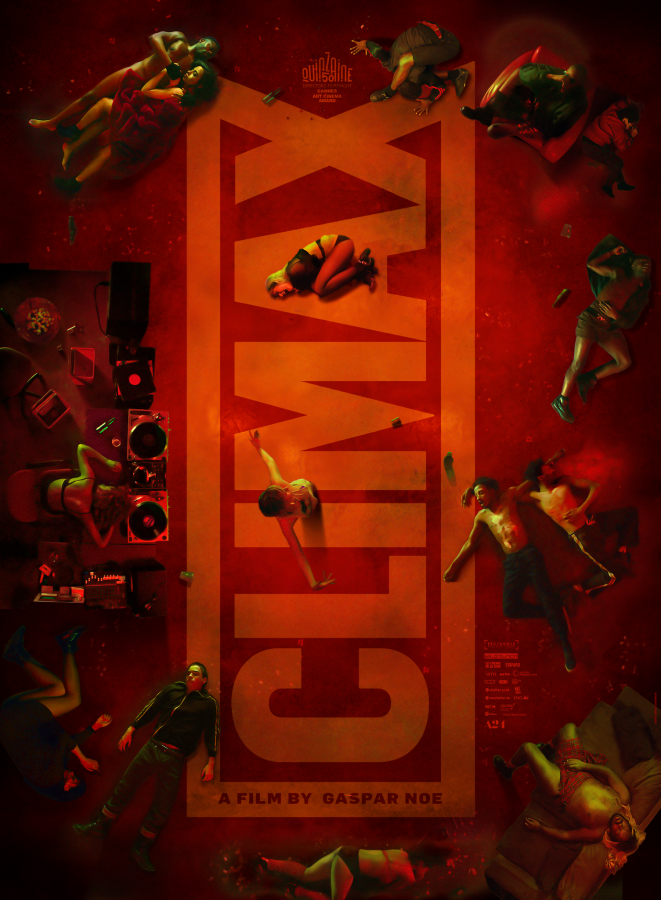The best nights are the ones that come unexpectedly — last-minute debauchery that catapults you into the adventure-filled and wondrous unknown. In “Climax,” French director and master of contemporary psychedelic cinema Gaspar Noé hosts a journey into the human psyche that you may never want to leave.
Set in the mid-90s, the story opens with a French dance troupe preparing for an upcoming competition in a school basement. Tensions run high as the audience is brought up to speed over 10 minutes of banter between pairs of dancers, each disclosing who they despise, envy and desire. As the team hosts a dance party after rehearsal, complete with a punch bowl of LSD-infused sangria, the night begins to go awry.
Once the first sip of sangria touches the lips of one of the protagonists, the film takes a dive headfirst into the hallucinatory realm: the beat drops, the brightness of the lights intensify and the opening credits begin to roll, a full 46 minutes in. And so it begins.
From there, it’s chaos — yet it is the most controlled, calculated chaos in Noé’s repertoire. Rather than CGI depictions of a sperm’s view during coitus or brutal rape scenes, Noé’s take on sex is tame here in comparison to his previous works. His take on the intersection of sex and the human condition is deeper and more mature this time around.
Relying on drug use to bring out characteristics of the human condition is hardly a new concept for the Argentinian director, but he hits a new note in “Climax,” as the longer time goes on — and the stronger the drug gets — the more humanity is brought out of our seemingly average protagonists.
“I have been to many parties that have turned wrong, but hopefully no one was dead at the end [of it],” Noé said in a phone interview with WSN. “Because of a party that has gone bad, I have never been to a police station or hospital, but if you go out at night, you very often see fights because alcohol and drugs turn a lot of great, loving people to crazy and evil.”
Roughly a dozen average protagonists are put before us at the onset of the film, all normal twentysomethings with hopes and dreams. Once the drug hits, however, we watch each character fall miserably into their own personal hellscapes, lost inside their own heads, behaving almost like ravenous animals at the very end. It is this ending that evokes the movie’s title — as most of the characters are bathed in red light, naked and furiously copulating, we are reminded of just how primal and nonsensical humans can be.
Here, Noé begs the question: is one night all it takes for someone to regress that way?
The vivacity and chaotic nature of our characters’ madness is not only represented in the script, but in the captivating performances from the trained cast of performers. In fact, save Selva — played by Sofia Boutella of “Atomic Blonde” and “The Mummy” — all the actors in the film were street dancers with little to no prior acting experience.
What’s more, the actors were encouraged to ad-lib. They were accompanied only by a loose script in an attempt to keep the film sentimental. Casting minimally trained actors was a conscious choice, according to Noé.
“It would’ve been impossible to make a movie about dancers with actors,” he said. “Dance is a natural skill that you enhance by practice. I casted based on charisma and dancing skill. What I like about these dancers is that they are exceptional in the originality of their language.”
And that they are: the opening dance number features layered performances from contemporary dancers as they contort their bodies first individually, then as a group to form one massive figure. Boutella’s solo during the trip proves to be another highlight, as she screams, flings herself against the wall and death drops in a ferocious fight with her own mind.
Along with the characters, the audience is also thrust into a pit of madness as painfully long takes featuring the camera creeping behind actors as they traverse dimly lit hallways into the void. We can hear the violent screams down the empty halls with the characters, almost as if we are inside a haunted house.
And sure, there are other reasons why some critics have panned the release: its esoteric musings on death and Freudian subtext are hardly new. There are long periods of no dialogue at all and even longer periods of the ensemble cast ruminating the consequences of abortion and the “occupational hazards” of analingus. However, Noé aims to portray reality, which can sometimes be filled with arbitrary banter and periods of silence.
To counterbalance the moments of the intermittent comedown, the audience is visually bombarded with vibrant colors, flashing beams of light and body contortions aplenty. Mentally, we are stuck with end credits at the beginning, beginning credits in the middle and a proto-plot twist matched with a hint of the supernatural.
Much like a good party, “Climax” is a visually stunning experience that will keep you on your toes. It delivers witty dialogue, fast-paced action and an unparalleled intensity that keeps us fixated until the sun comes up. And like only the best parties, we’ll tell our friends about it for years to come.
A version of this article appears in the Monday, March 11, 2019, print edition. Email Nicole Rosenthal [email protected].


























































































































































